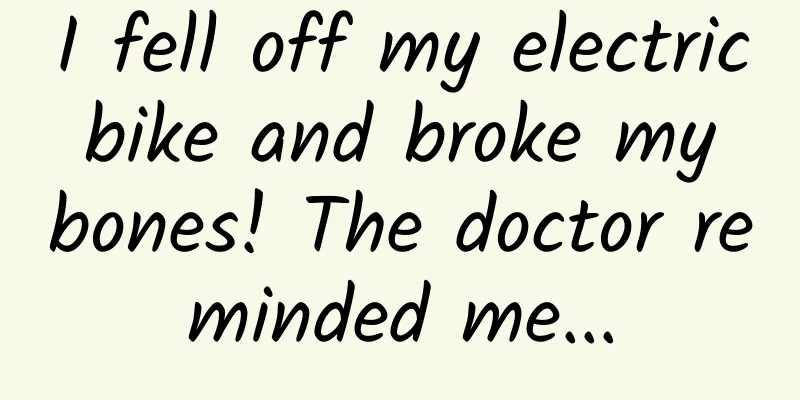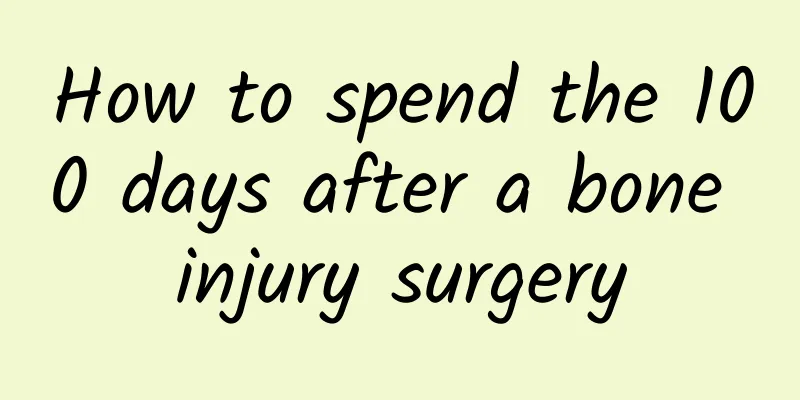I fell off my electric bike and broke my bones! The doctor reminded me...

|
Electric bikes have become a common means of transportation for the general public, but if you are careless, accidents may occur. This time, I asked a friend to share his experience. I believe that after reading his experience, you will be more careful when riding a bike. Subway transfers are annoying, taxis are expensive, and buying a car is not realistic. An electric car that only costs 2 yuan a day to charge has become my only choice for saving time and being the cheapest. But a small mistake not only ruined my two National Day holidays, but also caused me to be hospitalized twice, bedridden for several weeks, and a sum of medical expenses... not to mention the pain. Below is a summary of this unbearable experience, hoping to remind you who ride a bike. No one knows. Which will come first, the accident or tomorrow? On September 28, 2023 (the last working day before National Day), I was looking forward to the upcoming 8-day holiday. I rode my beloved electric donkey to work as usual. The sun was shining brightly all the way. I was thinking about the National Day arrangements in my mind. I had to attend a wedding banquet, go to the orchard to pick fruits, and go to... Duang!!! The car was going a bit too fast, the ground had just been sprinkled with water and the road conditions were unexpected, so I lost control and rear-ended the car in front of me. There was a loud bang and the world was spinning. When I came to my senses, I felt pain in my right foot when I moved it a little. I thought to myself, "Oh no, maybe I broke a bone?" So I took a taxi to the nearest tertiary hospital. I went to the hospital and took an X-ray, which showed that the 3rd and 4th toe bones (the part on the instep) were fractured, with the third toe bone broken and the fourth toe bone broken and dislocated. Image provided by the author Well, it's really a fracture, and it's not a minor one, so how can I treat it? The doctor said there are two options. The first is conservative treatment, which is to put on a plaster and go home to rest for two or three months and wait for the bone to grow. However, due to the dislocation, there may be hidden dangers in the future, so it is recommended to have surgery to reset the dislocated bone and fix it with a steel plate, which will recover faster and is more suitable for younger patients like me. Although surgery and steel plates are more expensive and troublesome, I love sports and I am afraid that the bones will grow crooked and leave hidden dangers. Otherwise, if I run or play sports in the future, the risk may be greater. So I chose surgery and applied for hospitalization. Although there is nothing wrong with this choice itself, in the end, my two National Day holidays were reimbursed... First surgery in life I have been in good health since I was a child. I have hardly caught a cold in recent years, let alone been to the hospital. I was nervous about having the surgery this time. The day before the operation, the doctor came to discuss the details of the operation, including fasting, drug allergies, medical history, surgical procedures, risks, postoperative recovery, etc. I also specifically mentioned to the doctor that I had just graduated and had not been working for long, and I hoped to arrange medication within the scope of medical insurance reimbursement as much as possible, because the cost was too high and I could not afford it. The attending doctor expressed his understanding. After the discussion and signing, the anesthesiologist also asked about my physical condition, medical history, drug allergy history, height and weight, etc. Due to the arrangement of the operating room, my surgery was delayed by 3 hours. The waiting was really uncomfortable. In addition, it was my first time to be pushed through the hospital while lying on a bed. I felt like a pig to be slaughtered and was a little nervous. After entering the operating room, the doctors were discussing my condition, and someone put me on an electrocardiogram, blood pressure, oxygen, and intravenous drip. I was a little nervous about the big show, and I was thinking, "Do I need oxygen for such a minor operation?" A few minutes later, the anesthesiologist asked me to lie on my side and bend over, and then he found a spot on my spine to inject anesthesia. Although the needle was a bit thick, the pain was different from the rumors, and the process was not that unbearable. After the doctor gave me a few injections, he pulled the flesh on my stomach a few times. I said I didn't feel anything at all, and the doctor was very satisfied - not feeling anything was the right thing to do. Then they disinfected and put a sterile cloth on it. During this time, I tried to pinch my right leg. It felt like I was grabbing something, but it was like pinching the mattress and it had nothing to do with me. I looked up and saw that my right leg was raised to 50-60 degrees, but it didn't feel uncomfortable at all. At this moment, I was a little terrified, but I was also in awe of the magic of anesthesia technology. In short, the anesthesia should be relatively successful, and I didn't feel any pain during the operation. When the operation was almost over, I could finally feel the doctors bandaging me, removing the needles and oxygen tubes. Then several doctors transferred me to a bed with wheels and pushed me back to the ward. After returning to the ward, the doctors inserted the oxygen tube and vital signs monitoring equipment. I could only lie down, but I couldn't sleep. I couldn't eat or drink for the next six hours, and could only moisten my lips with cotton swabs dipped in water. So far, everything was going well, until... Why is it so painful to remove the catheter? As we all know, surgery requires the insertion of a urinary catheter, which must then be removed after surgery, but this process is really hard to describe. About three hours after the operation, I felt more and more uncomfortable at the catheter site. It hurt no matter how I moved. After the anesthetic wore off, the pain became more intense, and I had to find an angle to breathe to relieve it. I couldn't help but ask the doctor if the catheter could be removed. The doctor said I had to wait until the next day. Time passed very slowly. After half an hour, I couldn't bear it anymore and had to ask for the catheter to be removed again. After consulting with the nurse, she told me that I could remove the catheter, but I might not be able to urinate. If not, I would have to reinsert it. I didn't care about that and asked the nurse to remove it. When she was doing it, she also told me that for men, the catheter should be inserted about 20 centimeters into the body, which was scary. Before I could react, the nurse had already removed the catheter. At that moment, I felt as if my soul had been sucked out, and my entire urinary tract was burning, but at least I didn't have the unbearable pain just now. After the catheter was removed, I immediately tried to use a urinal and found that I could urinate normally, but the urinary tract was burning and accompanied by small blood clots. Although it was still painful when urinating, I was finally free from the torture of the catheter. In the next few days, the urinary tract pain gradually subsided, and on the fifth day, it was completely back to normal. Recovery after surgery is not always smooth sailing I stayed in the hospital for almost a week after the operation, mainly taking anti-inflammatory and anti-swelling drugs. I changed the drugs every two days. I had a blood test and X-ray before leaving the hospital. After confirming that there was no problem, the doctor suggested that I continue to take anti-inflammatory drugs and change the drugs every two days. The doctor also left me contact information, so I can communicate at any time if I have any questions. I have to say that my attending doctor is very good. Although he is only one year older than me, he is very professional and thoughtful. A week later, I was almost ready to have my stitches removed. My attending doctor suggested that I remove them in two stages, so I went to a nearby private hospital to have them removed once. But when I went to the hospital for the second surgery and all the stitches were removed, I found that the wound had not completely healed, and there was a cavity under the scab. This may be because the private hospital was not careful enough in changing the dressing, or the materials used were not sterilized thoroughly. Looking back at the hospital where I had the surgery, each time the dressing was changed, disposable tools were used to thoroughly clean the wound. In the small private hospital, only a cloth bag of tweezers and a small amount of iodine were used for dressing changes, and the gauze may not be clean enough. As expected, the wound became infected. The wound is in poor condition. Photographed by the author The wound that was supposed to heal in two weeks took me another week to stay in the hospital. Every day I had to clean the wound, remove the dead skin edge, disinfect and rebandage it, and sew a stitch on the wound. The stitches without anesthesia were really painful, but I managed to get through it, and the wound finally got better. It seems that in the future, I must go to a reliable public hospital for such risky operations. This time I have learned my lesson. Another year has passed, and the painful memory of my foot injury has faded. I originally thought that I would go out and have fun during the 2024 National Day holiday to make up for it, but guess what? I have to remove the steel plate... After a lot of trouble in the hospital, I finally removed this little thing from my foot that had been in my body for a year. Photographed by the author The wound left by the steel plate removal this time is in much better condition than the previous infection. Photographed by the author However, although the steel plate was removed smoothly, the condition of my foot was definitely not suitable for going out for fun. So, another long vacation was ruined... How many National Day holidays are there in life? Some advice for everyone This injury really cost me money and health, and delayed things. After thinking it over, I summarized a few points: 1. Employee medical insurance must be paid on time. The total cost of my foot injury this time was about 15,000 yuan, I paid about 4,000 yuan, and the rest was reimbursed by medical insurance. Therefore, insurance is a necessary guarantee. 2. Pay attention to safety when traveling, especially those who ride bicycles. Obey traffic rules, safety is always the most important thing (I should have driven slower at that time). 3. Respect the doctor's professionalism. Although choosing the steel plate seemed a bit expensive and troublesome at the time, the current recovery effect is indeed good. 4. Choose a regular medical institution. I didn’t go to a big hospital to save trouble when removing the stitches, but ended up getting an infection and staying in the hospital for an extra week... 5. Health comes first, and a good companion is a blessing. Even the simplest things, such as paying bills or going upstairs, are very difficult for people who are bedridden. This time, my parents were unable to come and take care of me due to work. Thanks to my girlfriend's company and help during my hospitalization, I was able to successfully complete the treatment and recover and be discharged from the hospital. Finally, I would like to remind everyone again, be careful when riding a bicycle, it is better to ride slowly than to ride fast, and if you fall and get hurt once, you will never forget it... Doctor's comments: Fractures are indeed a health problem that requires great attention. If not handled properly, they may lead to long-term functional impairment and even seriously affect the quality of life. Therefore, once an accident occurs and the risk of fracture is suspected, it is crucial to seek medical attention in a timely manner. Through professional medical evaluation and imaging examinations, the severity of the fracture can be accurately determined and an appropriate treatment plan can be formulated. The three major principles of fracture treatment are reduction, fixation, and functional exercise. Some fractures, especially when there is dislocation, may seem to be just a problem with small bones, but if not treated in time, it may lead to limited joint function and affect the patient's mobility. Therefore, sometimes doctors may recommend surgical fixation, such as using steel plates or screws, to ensure that the bones heal in the correct position to restore normal function. It is recommended that you trust the doctor's judgment. In addition, I would like to remind everyone that even if the X-ray does not show obvious fractures, a full physical examination should be performed, and an MRI examination should be performed if necessary to rule out damage to the joint ligaments. As orthopedic surgeons, we have seen many patients injured in electric bicycle accidents in our clinics, including limb fractures, ligament injuries, and even life-threatening craniocerebral injuries. We also recommend that friends who ride electric bicycles wear helmets correctly, obey traffic rules, do not exceed speed limits, and avoid falls. In short, timely and professional treatment of fractures is the key to recovery. I hope everyone will pay more attention in daily life to avoid unnecessary injuries. Planning and production Author: Zhang Cong, a graduate student in agronomy and seed industry, majoring in vegetables Review comments | Ji Gang, deputy chief physician of orthopedics, the First Hospital of Hebei Medical University |
<<: [Medical Q&A] Is it possible for a person's blood type to change?
>>: [Medical Q&A] Does a positive hepatitis B virus surface antigen mean that you have hepatitis B?
Recommend
Can I take Panax notoginseng powder if I have breast hyperplasia?
Many women will experience breast hyperplasia, es...
Women's dangerous period
With the rapid development of today's society...
Top 10 Nuts That Pregnant Women Should Avoid
There are no top ten nuts that are taboo for preg...
Early symptoms of renal failure in women
If a woman has kidney failure, she should activel...
How many days does it take to sweat during the confinement period
Generally speaking, women need to sit in confinem...
Drinking glucose for more than one month of pregnancy
We all know that pregnant women need to consume a...
Will the stomach swell up when you are two months pregnant?
The feeling during pregnancy is very strange. It ...
What are the emergency measures for heavy bleeding in ectopic pregnancy?
Ectopic pregnancy is a common gynecological disea...
Is it normal to have no reaction at 6 weeks of pregnancy?
For some women, the symptoms of pregnancy are not...
Can you drink overnight or boiled water? Many people don’t expect the consequences!
Information source: "Tencent Medical Diction...
What to do if you have stomach pain and diarrhea in early pregnancy
Diarrhea and colds are common diseases in life. H...
How to take care of the yellow-green pus in leucorrhea?
Many women do not pay attention to personal hygie...
Why do labia swell?
Swollen labia refers to swelling of the vulva, wh...
What is the method to make private parts tighter?
Women's private parts will become loose, whic...









